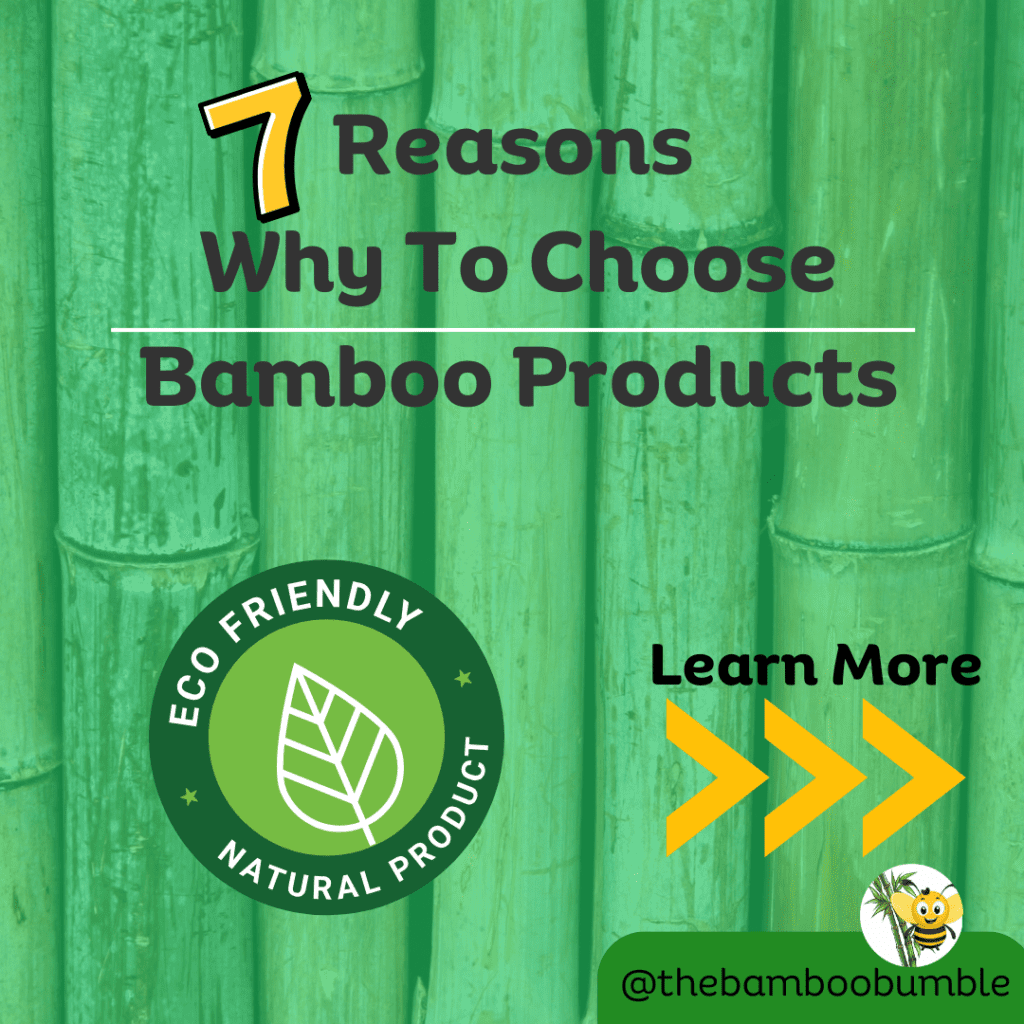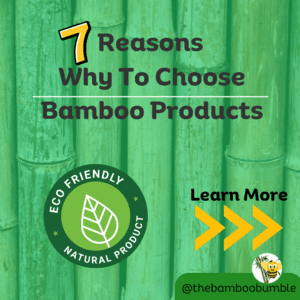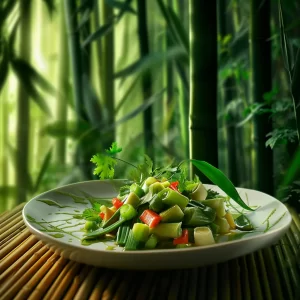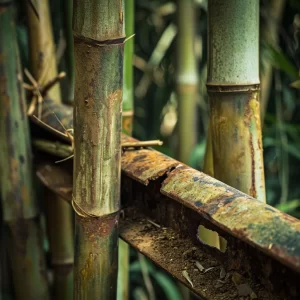11 Different Types of Bamboo and Their Uses
Did you know the Great Wall of China, a symbol of human defiance, is partly held together by bamboo? For centuries, this resourceful plant has woven itself into the fabric of human history, whispering tales of strength, resilience, and adaptation. Today, we’re revisiting its wisdom in a world desperately seeking sustainable solutions. 🌍♻️
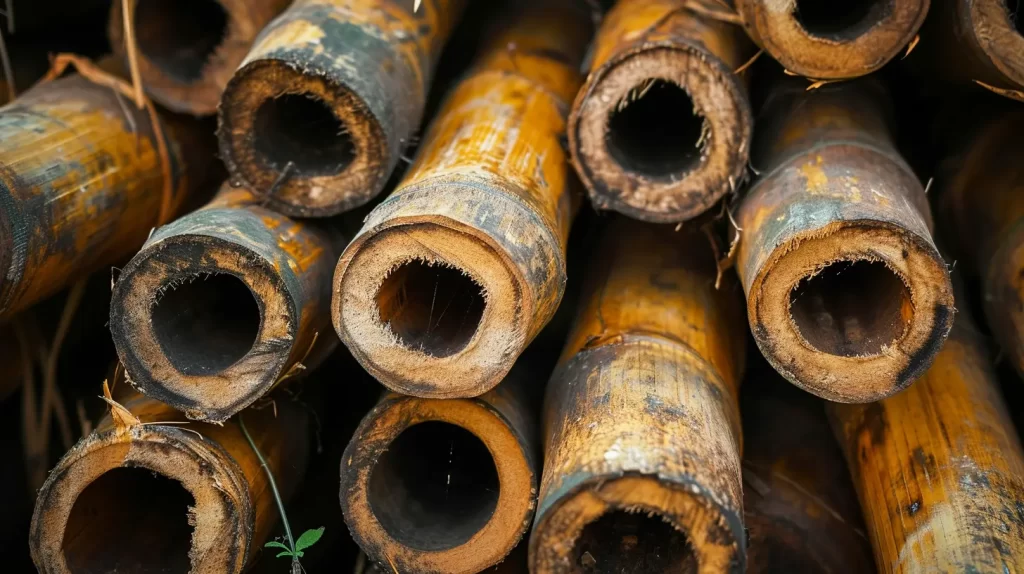
Bamboo is an incredibly versatile plant. In this article, we’re going to dig into the top seven different kinds of bamboo, their uses, and the environmental impact of each. This is super cool information that can help you make more informed decisions when choosing bamboo products to weave into your everyday life! 🌱🤓
Table of Contents
Bamboo Interesting Factoids
- The Fastest Grower on Earth: Forget Usain Bolt, bamboo takes the crown for the fastest-growing land plant! Certain species can shoot up an incredible 47 inches in just 24 hours. That’s like growing taller than most children in a single day! Imagine bamboo forests growing at warp speed.
- Not a Tree, but a Grass? You might be surprised to learn that bamboo isn’t actually a tree, but a giant grass! Despite its impressive height and woody culms, bamboo belongs to the same family as your lawn grass. So next time you admire a towering bamboo grove, remember you’re looking at a supersized blade of grass.
- Super Strong and Sustainable: Don’t underestimate bamboo’s strength! Some species are as strong as steel and can be used to build earthquake-resistant houses and bridges. Bamboo is also incredibly sustainable. It grows quickly, replenishes soil, and absorbs more carbon dioxide than trees, making it an eco-friendly choice for construction and other uses. ️♻️
- Edible and Delicious: Believe it or not, many bamboo species are edible! Young shoots can be enjoyed in stir-fries, soups, and even pickled. Some cultures even use bamboo leaves for tea and medicine. So next time you’re at the grocery store, keep an eye out for bamboo shoots – they might just become your new favorite ingredient.
- Musical Marvel: Bamboo isn’t just for building and eating; it can also be used to make music! Instruments like flutes, panpipes, and even drums can be crafted from bamboo, creating unique and beautiful sounds. So next time you hear a captivating melody, it might just be the song of the bamboo. 🪘
Now, let’s get into each of the different types! The focus here is on some of the most common that are used for products and commercial uses. There are many kinds that are used for decorative, but the ones below are more steered towards the ones you might find in furniture, clothing, and even toothbrushes!
Giant Timber Bamboo (Phyllostachys bambusoides)
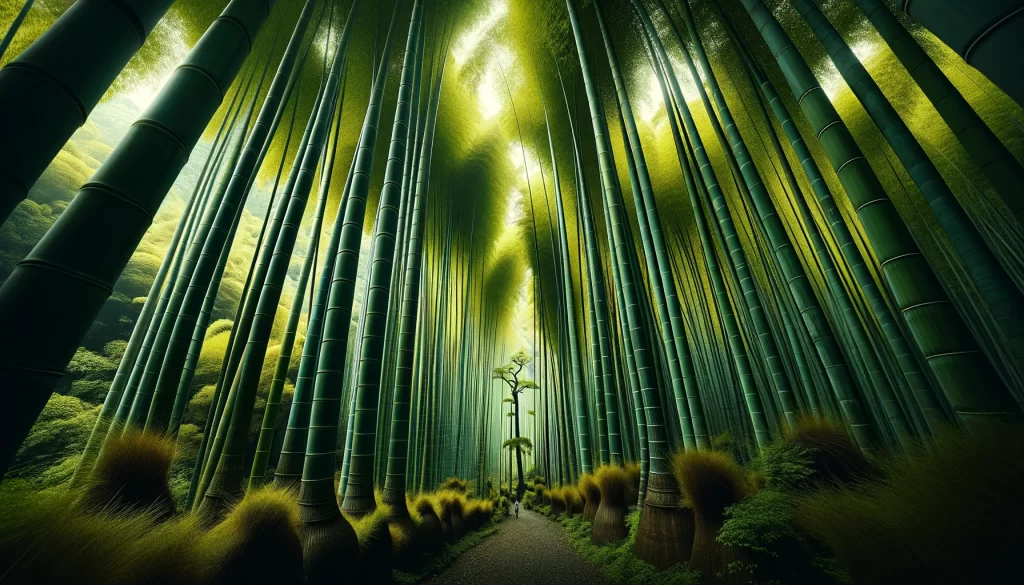
Giant Timber Bamboo, scientifically known as Phyllostachys bambusoides, is one of the most impressive and widely recognized bamboo species. Originating from China, it has become popular across the world, especially in temperate regions. Known for its towering height and strong wood, this bamboo is not only a marvel of natural engineering but also a symbol of traditional Asian culture.
Type of Bamboo
- Common Name: Giant Timber Bamboo
- Scientific Name: Phyllostachys bambusoides
- Origin and Geographical Distribution: Native to China; widely cultivated in temperate regions worldwide
Physical Characteristics
- Height and Diameter: Can grow up to 60-70 feet tall; diameter of 4-5 inches
- Color and Texture: Green canes that mature to a yellowish tint; smooth texture
- Growth Pattern: Running type, known for its aggressive spreading
Practical Uses
- Construction: Used for building materials, scaffolding, and in furniture making due to its strength
- Culinary Uses: Young shoots are edible
- Textiles and Paper Production: Fibers used in textile industries; pulp for paper
- Ornamental Gardening: Popular for landscaping due to its imposing size and aesthetic appeal
Innovative and Modern Uses
- Use in Eco-friendly Products: Used in making biodegradable utensils and eco-friendly packaging
- Role in Modern Architecture and Design: Incorporated in contemporary building designs for sustainable and aesthetic solutions
- Emerging Technologies: Research into using its fibers for advanced textiles
Sustainability Aspects
- Renewable Resource Qualities: Fast-growing, self-regenerating, and requires minimal pesticides and fertilizers
- Comparison with Other Materials: Offers a more sustainable alternative to wood and certain plastics, with a smaller carbon footprint
Ecological Impact
- Environmental Benefits: Excellent carbon sink, aids in soil stabilization
- Invasiveness or Environmental Concerns: Can be invasive due to its running growth habit, requires management in non-native regions
Cultural Significance
- Historical Uses and Significance: Long history of use in Asian cultures for construction and as a symbol of strength and flexibility
- Symbolism in Different Cultures: Often symbolizes resilience, longevity, and flexibility in various Asian cultures
Moso Bamboo (Phyllostachys edulis)
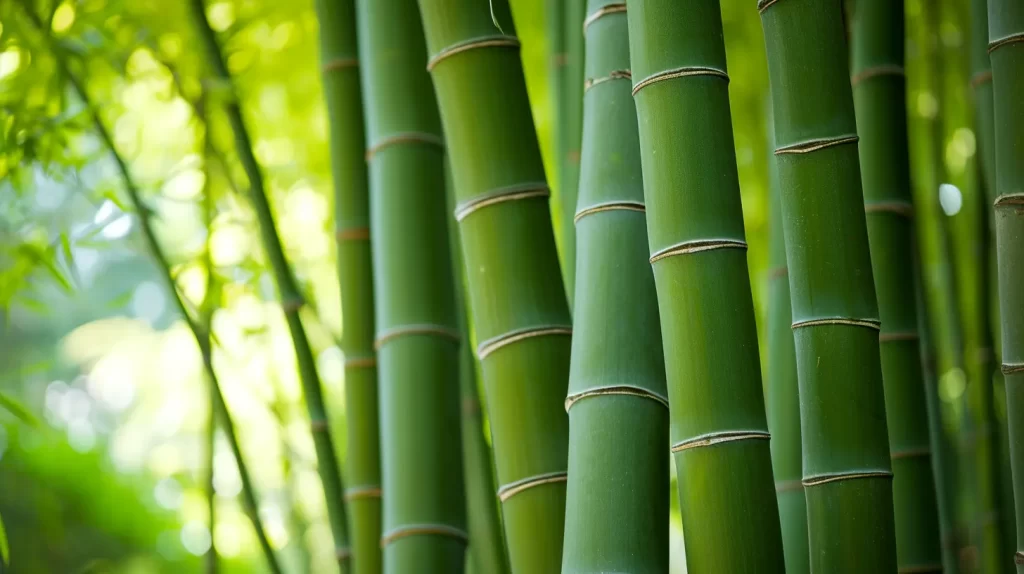
Moso Bamboo, known scientifically as Phyllostachys edulis, is one of the most important bamboo species in the world, especially in East Asia. It is renowned for its rapid growth and substantial height, making it a key species in both the economic and ecological aspects of the regions where it’s found. This bamboo not only plays a crucial role in traditional Asian cultures but has also gained significant global importance due to its versatility and sustainability.
Type of Bamboo
- Common Name: Moso Bamboo
- Scientific Name: Phyllostachys edulis
- Origin and Geographical Distribution: Native to China and Taiwan; extensively cultivated in East Asia
Physical Characteristics
- Height and Diameter: Typically reaches 50-70 feet, with a diameter of up to 7 inches
- Color and Texture: Green when young, turning to yellow or tan with age; smooth texture
- Growth Pattern: Running type, known for its rapid growth and expansive spread
Practical Uses
- Construction: Widely used in Asia for construction, especially in flooring, paneling, and furniture due to its strength and durability
- Culinary Uses: Shoots are a popular ingredient in Asian cuisine
- Textiles and Paper Production: Integral in the production of high-quality paper and increasingly used in textile manufacturing, like bamboo fiber clothing
- Ornamental Gardening: Valued for its aesthetic appeal and often used in large gardens and parks
Innovative and Modern Uses
- Use in Eco-friendly Products: Key material in the production of eco-friendly products, including clothing, reusable containers, and furniture
- Role in Modern Architecture and Design: Its structural properties are being explored in modern architecture for sustainable building solutions
- Emerging Technologies: Research into using its cellulose for biofuel production and other sustainable technologies
Sustainability Aspects
- Renewable Resource Qualities: Rapidly renewable, absorbs more CO2 than equivalent tree species
- Comparison with Other Materials: More sustainable and environmentally friendly compared to many wood species and synthetic materials
Ecological Impact
- Environmental Benefits: Plays a significant role in carbon sequestration and soil conservation
- Invasiveness or Environmental Concerns: Its aggressive growth can lead to dominance over native species if not managed properly
Cultural Significance
- Historical Uses and Significance: Deeply ingrained in East Asian cultures, used in various traditional crafts and as a symbol in art and literature
- Symbolism in Different Cultures: Often represents strength and flexibility, as well as purity and uprightness in Chinese culture
Dragon Bamboo (Dendrocalamus asper)
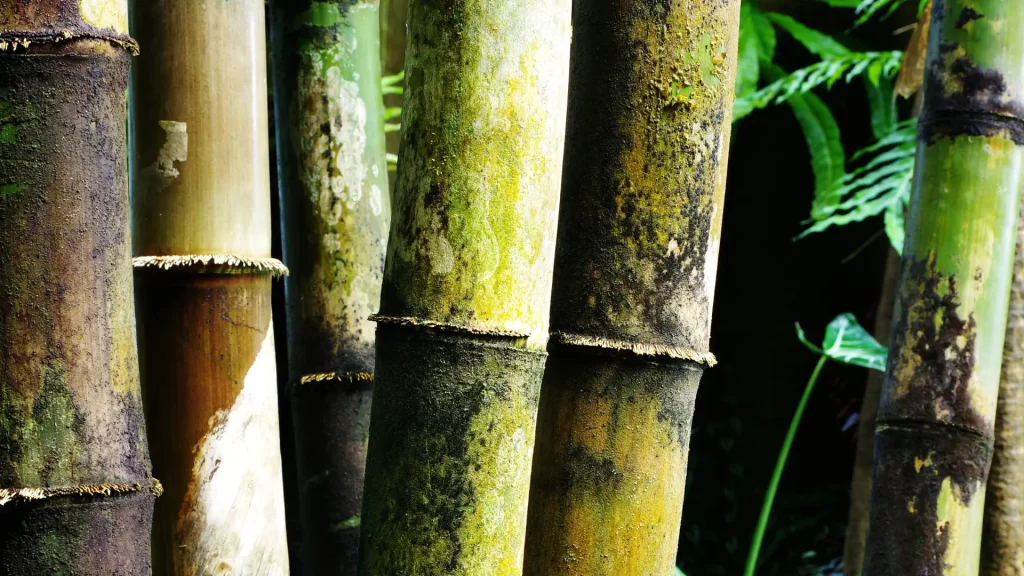
Dragon Bamboo, with its scientific name Dendrocalamus asper, is a striking species known for its robust size and unique aesthetic appeal. Originating from Southeast Asia, this bamboo is not only valued for its practical applications but also for its ornamental beauty. It’s a species that embodies strength and resilience, making it a favored choice in both traditional and modern contexts.
Type of Bamboo
- Common Name: Dragon Bamboo
- Scientific Name: Dendrocalamus asper
- Origin and Geographical Distribution: Native to Southeast Asia, particularly Indonesia, Thailand, and Malaysia
Physical Characteristics
- Height and Diameter: Can grow up to 60-100 feet tall, with a diameter of 6-12 inches
- Color and Texture: Green canes with a rough, textured surface
- Growth Pattern: Clumping type, making it less invasive than running bamboos
Practical Uses
- Construction: Highly valued for construction due to its strength and size, used in building structures, furniture, and musical instruments
- Culinary Uses: Young shoots are edible and used in traditional Southeast Asian cuisine
- Textiles and Paper Production: Used in local industries for paper and crafts
- Ornamental Gardening: Its impressive size and aesthetic makes it a popular choice for landscaping and ornamental purposes
Innovative and Modern Uses
- Use in Eco-friendly Products: Utilized in making eco-friendly products like household items and decorative objects
- Role in Modern Architecture and Design: Increasingly incorporated into modern architectural designs for its sustainability and unique appearance
- Emerging Technologies: Potential uses in green technology applications are being explored
Sustainability Aspects
- Renewable Resource Qualities: Fast-growing and self-regenerating, making it a sustainable resource
- Comparison with Other Materials: Offers a greener alternative to traditional timber and certain plastics, due to its lower environmental impact and carbon footprint
Ecological Impact
- Environmental Benefits: Contributes to carbon dioxide absorption and oxygen production, beneficial for soil health and erosion control
- Invasiveness or Environmental Concerns: Being a clumping variety, it poses less risk of invasiveness compared to running bamboo species
Cultural Significance
- Historical Uses and Significance: Has a rich history in Southeast Asian cultures, used traditionally in construction, crafts, and as a food source
- Symbolism in Different Cultures: Symbolizes strength, flexibility, and resilience in many Asian cultures, often associated with longevity and vitality
Female Bamboo (Bambusa balcooa)
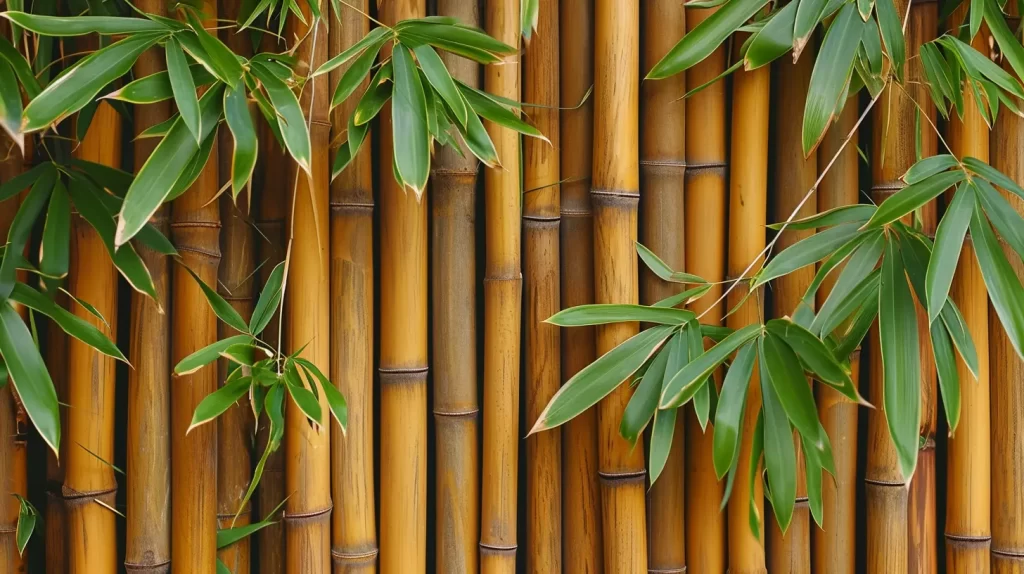
Female Bamboo, known scientifically as Bambusa balcooa, is a robust and versatile bamboo species native to South Asia. It is particularly noted for its thick walls and high strength, making it a valuable resource in various industries. This species is not just a practical asset but also holds cultural significance in the regions where it grows.
Type of Bamboo
- Common Name: Female Bamboo
- Scientific Name: Bambusa balcooa
- Origin and Geographical Distribution: Indigenous to South Asia, especially prevalent in India and Bangladesh
Physical Characteristics
- Height and Diameter: Typically grows to about 60-80 feet in height, with a diameter of 4-6 inches
- Color and Texture: Features a light green color that turns to a yellowish hue as it matures, with a smooth texture
- Growth Pattern: Clumping type, known for its dense growth and thick-walled culms
Practical Uses
- Construction: Widely used in construction for scaffolding, housing, bridges due to its high strength and durability
- Culinary Uses: The shoots are edible and used in local cuisines
- Textiles and Paper Production: Fibers are used in making paper and various traditional crafts
- Ornamental Gardening: Valued for its aesthetic appeal in gardens and parks
Innovative and Modern Uses
- Use in Eco-friendly Products: Employed in the production of sustainable household items and handicrafts
- Role in Modern Architecture and Design: Gaining popularity in eco-friendly building designs and interior decoration
- Emerging Technologies: Research is ongoing into its potential in renewable energy sectors and sustainable product development
Sustainability Aspects
- Renewable Resource Qualities: Rapid growth rate and natural regeneration make it a sustainable alternative to traditional timber
- Comparison with Other Materials: Offers environmental advantages over many hardwoods and synthetic materials due to its lower ecological footprint
Ecological Impact
- Environmental Benefits: Acts as a significant carbon sink and helps in soil erosion control
- Invasiveness or Environmental Concerns: As a clumping bamboo, it is less likely to be invasive and is easier to control than running bamboo varieties
Cultural Significance
- Historical Uses and Significance: Has a long history of use in South Asian cultures for building materials, handicrafts, and as a traditional food source
- Symbolism in Different Cultures: Often represents strength and resilience in local folklore and is associated with prosperity and protection in various cultural contexts
Black Bamboo (Phyllostachys nigra)
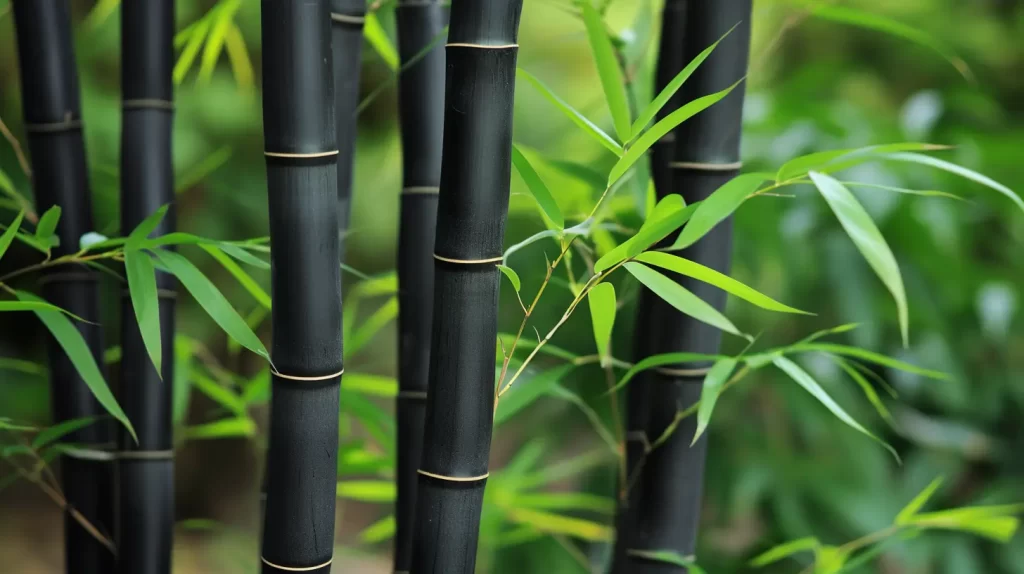
Black Bamboo, scientifically known as Phyllostachys nigra, is a unique and highly ornamental bamboo species, distinguished by its striking black-colored canes. Native to China, this bamboo is not only valued for its distinctive appearance but also for its versatility in various applications. It is a popular choice in gardens and landscapes, symbolizing elegance and mystery in many cultures.
Type of Bamboo
- Common Name: Black Bamboo
- Scientific Name: Phyllostachys nigra
- Origin and Geographical Distribution: Originally from China, now cultivated worldwide, especially in temperate regions
Physical Characteristics
- Height and Diameter: Grows to about 20-35 feet in height, with a diameter of 1-2 inches
- Color and Texture: Unique black-colored canes, which develop from green to black over 2-3 years; smooth texture
- Growth Pattern: Running type, known for its spreading habit
Practical Uses
- Construction: Used in crafting furniture, decorative items, and musical instruments for its unique color and fine grain
- Culinary Uses: Shoots are edible, though it’s more prized for ornamental purposes
- Textiles and Paper Production: Limited use in textiles; used in small-scale paper-making
- Ornamental Gardening: Highly sought after for landscaping due to its striking appearance and as a feature plant in gardens
Innovative and Modern Uses
- Use in Eco-friendly Products: Utilized in the creation of eco-friendly decorative items and accessories that highlight its distinctive color
- Role in Modern Architecture and Design: Increasingly featured in interior design and architectural accents for its aesthetic appeal
- Emerging Technologies: Potential uses in artistic and design-oriented applications are being explored
Sustainability Aspects
- Renewable Resource Qualities: Fast-growing and regenerative, making it a sustainable material choice
- Comparison with Other Materials: Offers a more environmentally friendly alternative to synthetic dyes and materials, especially in decorative applications
Ecological Impact
- Environmental Benefits: Contributes to carbon sequestration and oxygen production, beneficial for biodiversity
- Invasiveness or Environmental Concerns: As a running bamboo, it requires careful management to prevent it from becoming invasive in non-native environments
Cultural Significance
- Historical Uses and Significance: Historically used in China for various applications, its unique color has made it a symbol of elegance and mystery
- Symbolism in Different Cultures: Often associated with beauty, strength, and adaptability, and is a popular element in Asian gardens and art
Buddha Belly Bamboo (Bambusa vulgaris ‘Wamin’)
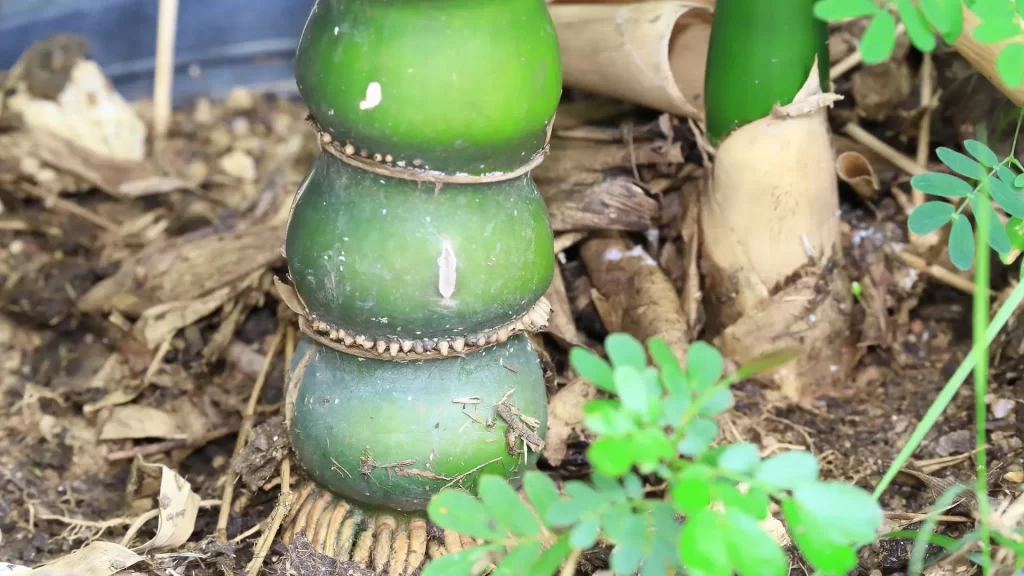
Buddha Belly Bamboo, known scientifically as Bambusa vulgaris ‘Wamin’, is a distinct and highly ornamental variety of bamboo. It’s most notable for its uniquely bulging internodes, resembling the belly of Buddha, from which it gets its name. This species is native to Southeast Asia and is admired not only for its unusual appearance but also for its adaptability and resilience.
Type of Bamboo
- Common Name: Buddha Belly Bamboo
- Scientific Name: Bambusa vulgaris ‘Wamin’
- Origin and Geographical Distribution: Originates from Southeast Asia, commonly cultivated in tropical and subtropical regions worldwide
Physical Characteristics
- Height and Diameter: Typically grows 10-15 feet tall, with a diameter of 2-3 inches
- Color and Texture: Green canes with a glossy texture and distinctive swollen internodes
- Growth Pattern: Clumping type, making it a less invasive species
Practical Uses
- Construction: Limited use in construction due to its shape, but sometimes used in crafting small decorative items
- Culinary Uses: Young shoots are edible and used in local culinary traditions
- Textiles and Paper Production: Not widely used in textiles or paper production due to its unique structure
- Ornamental Gardening: Highly prized as an ornamental plant for its unique shape and aesthetic appeal in gardens
Innovative and Modern Uses
- Use in Eco-friendly Products: Utilized in the production of niche eco-friendly products and artistic crafts
- Role in Modern Architecture and Design: While not widely used in large-scale construction, it’s sought after for decorative and landscape design purposes
- Emerging Technologies: Potential for use in specialized artistic and design projects
Sustainability Aspects
- Renewable Resource Qualities: As a fast-growing bamboo, it’s a sustainable choice for ornamental purposes
- Comparison with Other Materials: Offers an eco-friendly alternative for decorative uses compared to non-renewable materials
Ecological Impact
- Environmental Benefits: Contributes to carbon absorption and provides oxygen, beneficial for local ecosystems
- Invasiveness or Environmental Concerns: Being a clumping variety, it poses minimal risk of becoming invasive and is easier to manage in a garden or landscaped setting
Cultural Significance
- Historical Uses and Significance: While not historically significant for practical uses, it has a strong ornamental and cultural presence in Southeast Asian countries
- Symbolism in Different Cultures: Symbolizes good fortune and prosperity, often used in landscapes to bring a sense of harmony and peace
Painted Bamboo (Bambusa vulgaris ‘Vittata’)
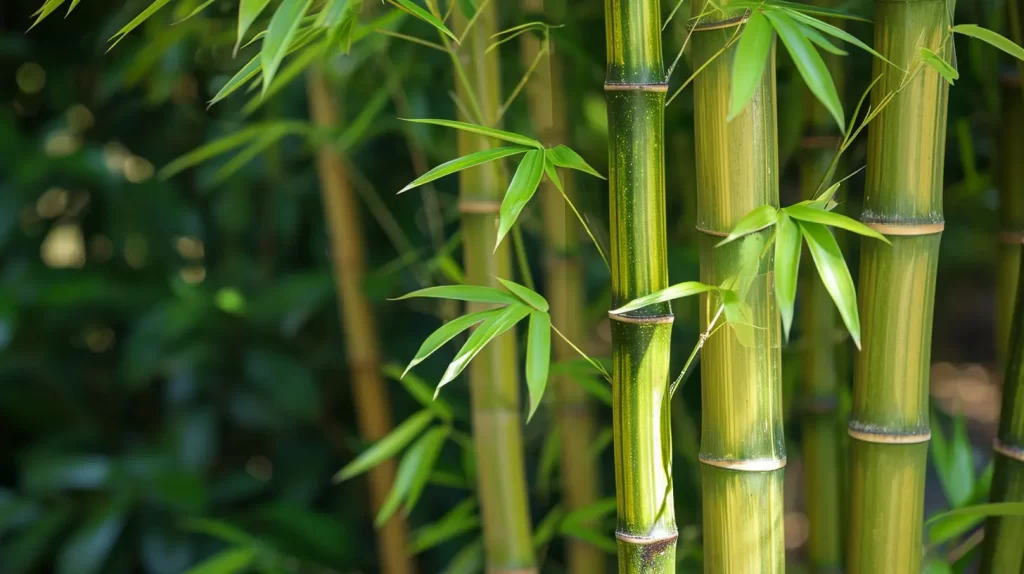
Painted Bamboo, scientifically named Bambusa vulgaris ‘Vittata’, is a visually striking variety known for its distinctively patterned canes. This bamboo, often referred to as ‘Striped Bamboo’, is native to Southeast Asia and is celebrated for its decorative yellow stripes against a green backdrop, resembling a painted surface. It’s a popular ornamental species in tropical and subtropical regions, valued for both its beauty and versatility.
Type of Bamboo
- Common Name: Painted Bamboo
- Scientific Name: Bambusa vulgaris ‘Vittata’
- Origin and Geographical Distribution: Indigenous to Southeast Asia, widely cultivated in tropical and subtropical areas globally
Physical Characteristics
- Height and Diameter: Grows to about 40-50 feet tall, with a diameter of 2-3 inches
- Color and Texture: Characterized by bright green canes with yellow stripes, offering a unique and attractive appearance; smooth texture
- Growth Pattern: Clumping type, which tends to be more manageable and less invasive
Practical Uses
- Construction: While not commonly used in construction, it’s occasionally used for making small decorative objects and furniture
- Culinary Uses: Shoots are edible, though it is more valued for its ornamental properties
- Textiles and Paper Production: Not typically used in textiles or paper production due to its ornamental nature
- Ornamental Gardening: Highly sought after for landscaping and garden design for its striking appearance and aesthetic value
Innovative and Modern Uses
- Use in Eco-friendly Products: Employed in crafting unique, eco-friendly decorative items and garden accents
- Role in Modern Architecture and Design: Occasionally featured in modern design projects for its distinct visual appeal
- Emerging Technologies: Potential for use in creative and artistic applications, exploring its unique coloration and pattern
Sustainability Aspects
- Renewable Resource Qualities: A fast-growing, sustainable option for ornamental planting
- Comparison with Other Materials: Provides an eco-friendlier alternative for decorative purposes compared to synthetic ornamental plants
Ecological Impact
- Environmental Benefits: Assists in carbon sequestration and oxygen production, beneficial for the environment
- Invasiveness or Environmental Concerns: As a clumping species, it has a lower risk of invasiveness and is more suitable for controlled garden environments
Cultural Significance
- Historical Uses and Significance: Noted more for its ornamental value than historical use, it has become a symbol of beauty and uniqueness in garden design
- Symbolism in Different Cultures: Often associated with artistic expression and creativity, reflecting the aesthetic appeal and distinctive pattern of its canes
Golden Moso (Phyllostachys pubescens)
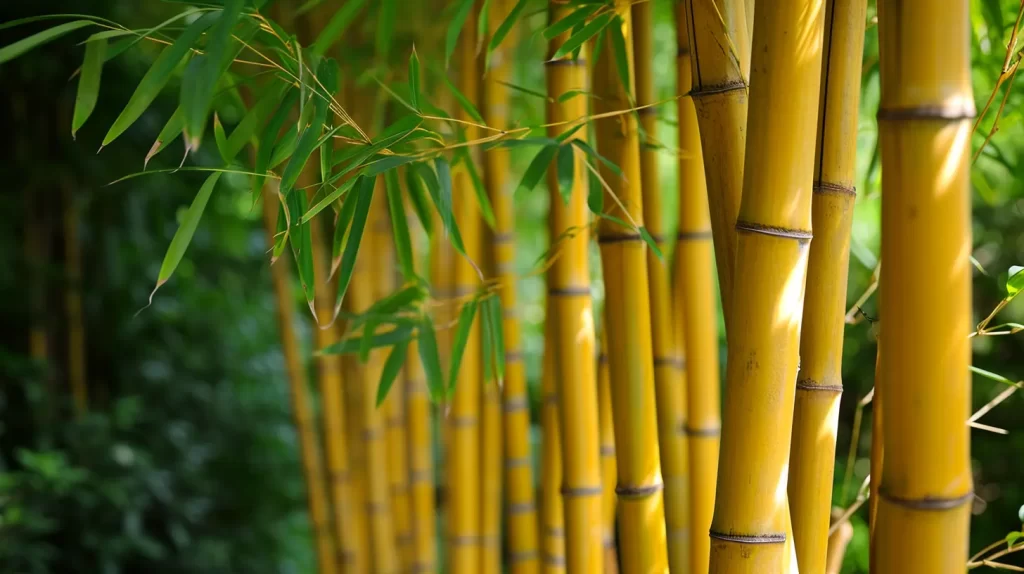
Phyllostachys pubescens, sometimes called “Golden Moso,” reigns supreme in the textile world. Its luxurious golden culms hold fibers famed for their exceptional softness and breathability, transforming into garments and bedding that feel like a whisper against the skin. Beyond fashion, its fast growth and impressive height make it a versatile player in construction and garden design, while its graceful form and fuzzy culms add a touch of understated elegance to any space.
Type of Bamboo
- Common Name: Moso Bamboo
- Scientific Name: Phyllostachys pubescens
- Origin and Geographical Distribution: Moso Bamboo, scientifically known as Phyllostachys pubescens, is native to China and is primarily found in the provinces of Zhejiang, Anhui, and Fujian. It has also been cultivated in other regions with suitable climates.
Physical Characteristics
- Height and Diameter: Moso Bamboo is one of the tallest bamboo species, known to reach heights of 50-70 feet or more. The culms (stems) have diameters ranging from 5 to 7 inches.
- Color and Texture: When young, the culms have a bright green color, which gradually turns yellowish with age. The texture of the culms is smooth.
- Growth Pattern: Moso Bamboo is a running bamboo, spreading through underground rhizomes.
Practical Uses
- Construction: Moso Bamboo is widely used in construction for scaffolding, furniture, and flooring due to its strength and versatility.
- Culinary Uses: The young shoots of Moso Bamboo are edible and are used in various culinary dishes, especially in Asian cuisine.
- Textiles and Paper Production: The fibers from Moso Bamboo are used in textiles and paper production.
- Ornamental Gardening: Moso Bamboo is also prized for its ornamental value in gardens and landscapes.
Innovative and Modern Uses
- Use in Eco-friendly Products: Moso Bamboo is used in the production of eco-friendly products like biodegradable utensils.
- Role in Modern Architecture and Design: It plays a role in modern architecture and design, including bamboo-inspired architectural structures.
- Emerging Technologies: Moso Bamboo fibers are explored for use in textiles, contributing to sustainable fashion.
Sustainability Aspects
- Renewable Resource Qualities: Moso Bamboo is a fast-growing and renewable resource, making it an environmentally friendly choice.
- Comparison with Other Materials: It offers an eco-friendlier alternative to materials like wood and plastic.
Ecological Impact
- Environmental Benefits: Moso Bamboo contributes to carbon sequestration and soil stabilization, providing environmental benefits.
- Invasiveness or Environmental Concerns: Its running growth pattern can be invasive if not managed properly, but it is less invasive than some other bamboo species.
Cultural Significance
- Historical Uses and Significance: Moso Bamboo has historical significance in Chinese culture, being used for various practical purposes.
- Symbolism in Different Cultures: It may symbolize strength, resilience, and adaptability in different cultures.
Japanese Arrow Bamboo (Sasa palmata)
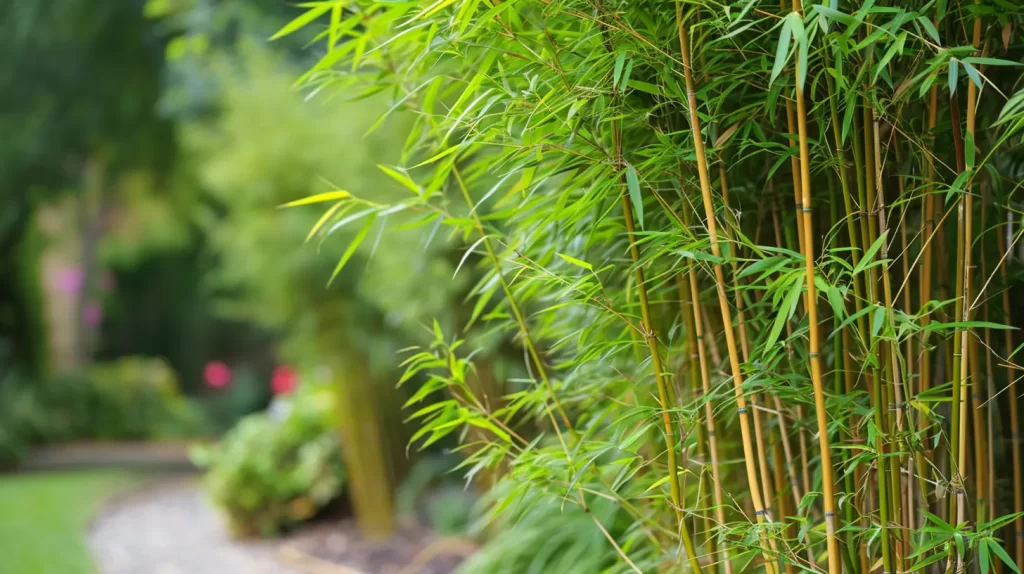
Japanese Arrow Bamboo (Sasa palmata) is a distinctive bamboo species native to Japan, with a unique presence in cool and temperate regions. It typically grows to heights of 3 to 6 feet, characterized by slender culms with vibrant green coloration and a smooth texture. Japanese Arrow Bamboo is renowned for its ornamental value in landscaping, imparting an elegant and delicate ambiance to gardens and landscapes. While primarily cultivated for its aesthetic appeal, some regional cuisines incorporate the edible young shoots of this bamboo into traditional dishes, adding a culinary dimension to its versatility. This bamboo species contributes to environmental preservation by providing habitat for wildlife and helping to prevent soil erosion in garden ecosystems.
Type of Bamboo
- Common Name: Japanese Arrow Bamboo
- Scientific Name: Sasa palmata
- Origin and Geographical Distribution: Japanese Arrow Bamboo, scientifically known as Sasa palmata, is native to Japan and is also found in parts of China and Korea. It is particularly abundant in the cool and temperate regions of Japan.
Physical Characteristics
- Height and Diameter: Japanese Arrow Bamboo is a relatively short bamboo species, typically reaching heights of 3-6 feet. The culms (stems) are slender, with diameters of about 0.25 inches.
- Color and Texture: The culms have a vibrant green color and a smooth surface.
- Growth Pattern: Japanese Arrow Bamboo is a clumping bamboo, forming dense clusters of culms close to the parent plant.
Practical Uses
- Ornamental Gardening: Japanese Arrow Bamboo is primarily used for ornamental purposes in gardens and landscapes. It is prized for its elegant and delicate appearance, making it a popular choice for landscaping.
- Culinary Uses: In some regions, young shoots of Japanese Arrow Bamboo are edible and used in traditional Japanese cuisine, although they are less commonly consumed than other bamboo species.
Innovative and Modern Uses
- Ornamental Landscaping: Its aesthetic appeal and ability to create privacy screens make Japanese Arrow Bamboo a valuable choice in modern landscaping.
- Crafts and Decor: Culms of this bamboo species are sometimes used in crafts and decorative arrangements due to their slender and graceful appearance.
Sustainability Aspects
- Environmental Benefits: Japanese Arrow Bamboo contributes to environmental conservation by providing habitat for wildlife and stabilizing soil in gardens and landscapes.
- Non-Invasiveness: It is a non-invasive bamboo, making it suitable for controlled garden environments without the risk of spreading uncontrollably.
Ecological Impact
- Wildlife Habitat: Japanese Arrow Bamboo provides habitat for small wildlife and insects, making it a valuable component of garden ecosystems.
- Soil Erosion Control: Its dense growth helps in preventing soil erosion in gardens and landscapes.
Cultural Significance
- Traditional Japanese Gardens: Japanese Arrow Bamboo has a long history of use in traditional Japanese gardens, symbolizing elegance and simplicity.
- Zen Aesthetics: It is often associated with Zen aesthetics, contributing to the tranquil ambiance of Zen gardens.
Sasa Bamboo (Sasa spp)
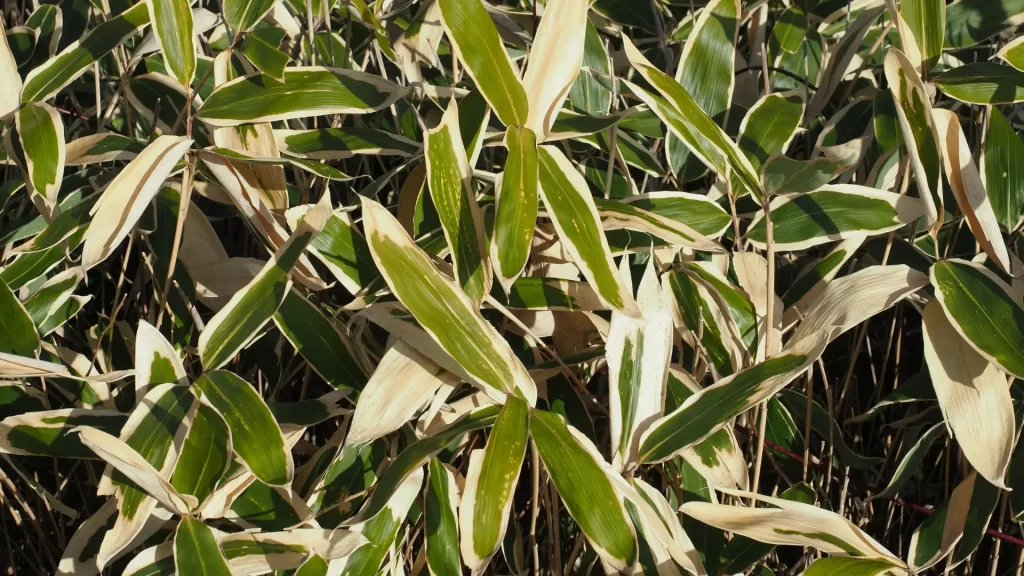
Sasa Bamboo, collectively known as Sasa spp, encompasses a diverse group of bamboo species native to Asia, including Japan, China, Korea, and Southeast Asia. These bamboos are appreciated for their adaptability and ornamental value in gardens and landscapes. With heights ranging from 3 to 6 feet and slender culms, Sasa Bamboo exhibits a graceful and delicate appearance. While it is primarily used for ornamental landscaping, certain species have culinary uses, with young shoots being consumed in traditional Asian cuisine. Additionally, Sasa Bamboo contributes to environmental conservation by providing wildlife habitat and aiding in soil erosion control, making it a valuable choice for sustainable landscaping.
Type of Bamboo
- Common Name: Sasa Bamboo
- Scientific Name: Sasa spp
- Origin and Geographical Distribution: Sasa Bamboo species, collectively known as Sasa spp, are native to various regions in Asia, including Japan, China, Korea, and parts of Southeast Asia. They are adapted to diverse climates and habitats within these regions.
Physical Characteristics
- Height and Diameter: Sasa Bamboo species vary in height, with some species reaching heights of 3-6 feet, while others may grow taller. The culms (stems) are typically slender, with diameters ranging from 0.25 to 0.5 inches, depending on the species.
- Color and Texture: The culms of different Sasa Bamboo species may vary in color, ranging from vibrant green to yellowish-green. They often have a smooth and glossy surface.
- Growth Pattern: Sasa Bamboo species exhibit both clumping and running growth patterns, depending on the specific species. Some form tight clumps, while others spread through underground rhizomes.
Practical Uses
- Ornamental Gardening: Sasa Bamboo species are widely used for ornamental purposes in gardens and landscapes. Their graceful appearance and adaptability make them popular choices for landscaping.
- Culinary Uses: In some regions, young shoots of certain Sasa Bamboo species are edible and used in traditional Asian cuisine, particularly in Japan and Korea.
Innovative and Modern Uses
- Landscaping and Privacy Screens: Due to their aesthetic appeal and ability to create privacy screens, Sasa Bamboo species are valuable in modern landscaping and garden design.
- Crafts and Decor: Culms of various Sasa Bamboo species are sometimes used in crafts and decorative arrangements because of their slender and elegant appearance.
Sustainability Aspects
- Environmental Benefits: Sasa Bamboo species contribute to environmental conservation by providing habitat for wildlife, stabilizing soil in gardens and landscapes, and sequestering carbon.
- Growth Patterns: Depending on the species, some Sasa Bamboo are non-invasive (clumping) and suitable for controlled garden environments, while others require careful management due to their running growth pattern.
Ecological Impact
- Wildlife Habitat: Sasa Bamboo provides habitat for small wildlife and insects, enhancing biodiversity in gardens and landscapes.
- Soil Erosion Control: The dense growth of Sasa Bamboo species helps prevent soil erosion, making them valuable in erosion-prone areas.
Cultural Significance
- Traditional Asian Gardens: Sasa Bamboo has a long history of use in traditional Asian gardens, symbolizing elegance and simplicity.
- Cultural Significance: In Japan, bamboo has cultural significance and is associated with various festivals and rituals.
Sweet Bamboo (Dendrocalamus latiflorus)
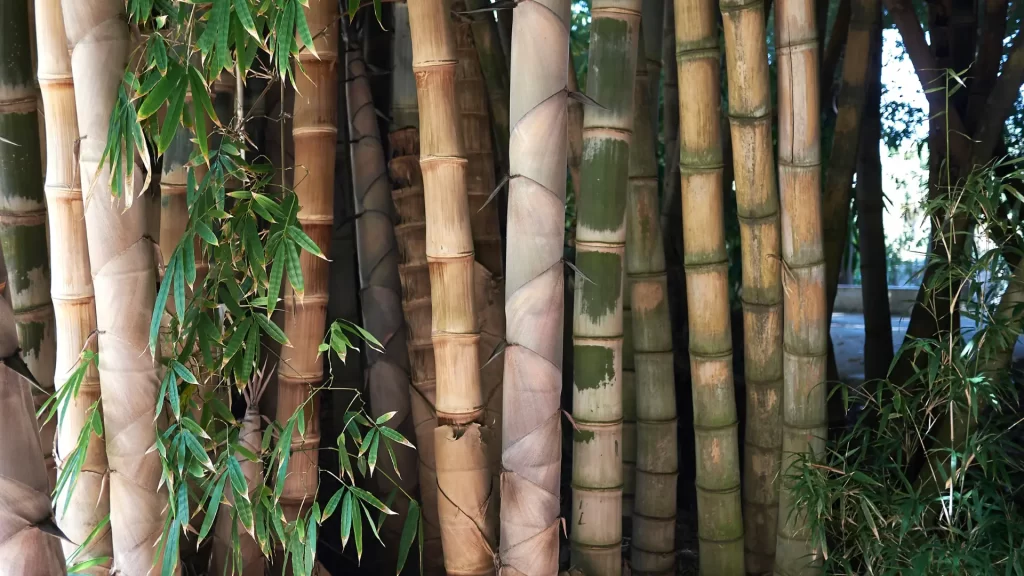
Sweet Bamboo (Dendrocalamus latiflorus), native to Southeast Asia, is a magnificent bamboo species known for its towering presence in tropical and subtropical regions. With heights reaching up to 100 feet and robust culms up to 8 inches in diameter, it is a symbol of strength and versatility. Its green-to-yellowish-brown culms add a touch of elegance to the landscape, making it a favorite in construction for scaffolding and structural purposes. Beyond its practical applications, Sweet Bamboo contributes to environmental conservation, sequestering carbon, and providing habitat for wildlife, further enhancing its ecological importance.
Type of Bamboo
- Common Name: Sweet Bamboo
- Scientific Name: Dendrocalamus latiflorus
- Origin and Geographical Distribution: Sweet Bamboo, scientifically known as Dendrocalamus latiflorus, is native to Southeast Asia and is commonly found in countries such as China, Vietnam, Thailand, and Indonesia. It thrives in tropical and subtropical climates.
Physical Characteristics
- Height and Diameter: Sweet Bamboo is one of the larger bamboo species, capable of reaching towering heights of 60-100 feet. The culms (stems) are robust and can have diameters ranging from 4 to 8 inches.
- Color and Texture: The culms of Sweet Bamboo are typically green when young, turning yellowish-brown as they mature. They have a smooth and glossy surface.
- Growth Pattern: Sweet Bamboo is a clumping bamboo, forming dense clusters of culms close to the parent plant.
Practical Uses
- Construction: Sweet Bamboo is widely used in construction for scaffolding, housing, and various structural purposes due to its strength and size.
- Culinary Uses: In some regions, the young shoots of Sweet Bamboo are edible and used in traditional Asian cuisine.
- Textiles and Paper Production: The fibers from Sweet Bamboo are utilized in textiles and paper production.
- Ornamental Gardening: Sweet Bamboo is also appreciated for its ornamental value in gardens and landscapes.
Innovative and Modern Uses
- Use in Eco-friendly Products: Sweet Bamboo is employed in the production of eco-friendly products, including biodegradable utensils and bamboo-based materials.
- Role in Modern Architecture and Design: It plays a role in modern architecture and design, particularly in tropical and eco-friendly building projects.
- Emerging Technologies: Sweet Bamboo fibers are explored for use in textiles and as a sustainable alternative in various industries.
Sustainability Aspects
- Renewable Resource Qualities: Sweet Bamboo is known for its rapid growth and renewable qualities, making it an environmentally friendly choice.
- Comparison with Other Materials: It offers an eco-friendly alternative to materials like wood and plastic.
Ecological Impact
- Environmental Benefits: Sweet Bamboo contributes to carbon sequestration and soil stabilization, providing significant environmental benefits.
- Invasiveness or Environmental Concerns: It is generally non-invasive and well-suited for controlled cultivation.
Cultural Significance
- Traditional Uses: Sweet Bamboo has a long history of use in traditional Asian cultures, where it holds cultural and economic significance.
- Symbolism in Different Cultures: Bamboo holds symbolism in various cultures, often representing strength, resilience, and versatility.
That’s a Wrap: Bamboo Possibilities
Bamboo isn’t just a sturdy material for chopsticks or a tropical backdrop for Instagram selfies. It’s a revelation! This versatile grass, with its lightning-fast growth and myriad uses, offers sustainable solutions for everything from construction and textiles to music and medicine. Whether you’re building an eco-conscious home or simply looking for ways to green your everyday life, bamboo is the eco-warrior material waiting to be embraced. So next time you encounter this fascinating plant, remember, it’s not just a pretty stalk – it’s a potential for a greener, more sustainable future. Let’s weave bamboo into our lives, one culm at a time!

Additional Reading
Phyllostachys Edulis ‘Moso’ | Bamboo Plants HQ
List of bamboo species – Wikipedia
Bamboo FAQ
What is a bamboo culm?
A bamboo culm is the vertical stalk of a bamboo plant. It’s made up of hollow sections joined by nodes, giving bamboo its characteristic segmented appearance. Culms can reach various heights and diameters depending on the bamboo species.
How does bamboo thrive in different climates?
Bamboo’s adaptability is impressive. While most prefer moist soil and partial shade, specific species:
- Tropical zones: Thrive in warm, humid environments like those found in Southeast Asia.
- Temperate zones: Can withstand colder temperatures and even snowfall, like certain Japanese bamboos.
- Indoor environments: Certain dwarf or slow-growing species adapt well to indoor pots and controlled climates.
Clumping vs. Running Bamboo: Key Differences
- Clumping bamboo: Grows in dense, clumping clusters, spreading slowly through underground rhizomes. Requires minimal management and is ideal for contained spaces.
- Running bamboo: Spreads aggressively via extensive underground rhizomes, quickly forming large groves. Requires regular management to prevent unwanted spread and potential landscaping disruptions.
Key Characteristics of Bamboo Plant Types:
- Slender, green leaves: Bamboo leaves are typically long and narrow, adding elegance and movement to the plant.
- Nodes: The horizontal rings along the culms mark points of stem growth and add a distinctive visual element.
- Evergreen: Most bamboos retain their foliage year-round, providing consistent visual interest in landscapes.
- Diverse sizes and shapes: From dwarf varieties perfect for indoor pots to giants reaching over 70 feet, bamboo offers options for various aesthetic and functional needs.
Can Bamboo Be Grown Indoors?
Absolutely! Certain dwarf and slow-growing bamboo species, like “Lucky Bamboo” (Dracaena sanderiana), are well-suited for indoor environments. They require moderate light and watering, making them low-maintenance additions to homes and offices.
Are All Bamboos Native to Specific Regions?
While some popular bamboos originated in regions like Japan and China, the plant family has a surprisingly diverse global distribution. Several bamboo species are native to Africa, North and South America, and even Europe, showcasing their adaptability to various climates and ecosystems.
How Fast Do Different Bamboos Grow?
Bamboo growth rates vary significantly depending on species and environmental conditions. Some:
- Rapidly growing giants: Certain bamboos can add several feet of culm height per day, requiring careful consideration for placement and management.
- Slower, steady growers: Other species grow more gradually, making them better suited for smaller spaces or those seeking a less demanding ornamental plant.

